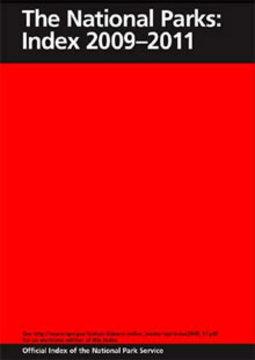Note: Don't click on the links until after you've read the article. The links connect to (large) downloads that begin automatically.
The new National Parks: Index 2009-2011 is now available online as well as in print. Download the searchable PDF version to your desktop and you’ll have a very handy reference. The file is on the large side (8.23 MB) and will take a while to load, but it’s worth the wait.
There is also an HTM version of the index, and you can always buy a printed copy if you prefer.
This publication, widely referred to "the Red Book” because of its distinctive red cover, is the official index of the National Park Service. It consists of 131 pages presenting a comprehensive administrative listing of the National Park System’s parks, affiliated areas, national heritage areas, wild & scenic rivers, and national trails. The entries are grouped by state. Each entry includes administrative addresses and phone numbers, dates of authorization and establishment, boundary change dates, acreages. Accompanying each entry is a very brief statement – just a sentence or two -- explaining the areas’ national significance. There is a handy alphabetical listing at the rear that identifies the host state and provides the index page number as well as the full name of the national park or other administrative unit.
A highly useful attribute of the PDF version of the index is the ease with which you can conduct both scroll-through and keyword searches. To perform the latter, just type keyword(s) into the “Find” box at the upper right, then select the kind of search you’d like to do -- either Find Next in Current PDF or open Full Reader Search. If you like, you can restrict to whole words only and specify case-sensitive.
Be sure to use the magnification (zoom) that best suits your needs. I like 75% for quick scroll-through searches and 100% for reading.
Use this reference with due caution when dealing with recently authorized units, redesignations, boundary changes, etc. The index is revised only every two years to reflect congressional actions. This new edition incorporates the actions of the 111th Congress through January 9, 2009.
The index was still in production on March 30, 2009, when the Omnibus Public Land Management Act of 2009 (PL 111-11) was signed into law. The Omnibus Bill authorized nine new national heritage areas, two waterways within the National Wild and Scenic Rivers System, and four new trails within the National Trails System.
The 13 new areas lacking entries in the NPS Index are:
New National Heritage Areas
• Muscle Shoals National Heritage Area (AL)
• Kenai Mountains-Turnagain Arm National Heritage Area (AK)
• Sangre de Cristo National Heritage Area (CO)
• South Park National Heritage Area, Colorado
• Baltimore National Heritage Area, Maryland
• Freedom’s Way National Heritage Area (MA and NH)
• Mississippi Delta National Heritage Area (MS)
• Northern Plains National Heritage Area (ND)
• Mississippi Hills National Heritage Area (MS)
New National Wild and Scenic Rivers
• Taunton River (MA)
• Snake River Headwaters (WY)
New National Trails
• Arizona National Scenic Trail
• New England National Scenic Trail
• Pacific Northwest National Scenic Trail
• Washington-Rochambeau Revolutionary Route National Historic Trail
You won’t find this index very useful as a visitor guide, since it lacks vital information pertaining to facilities, services, amenities, and other important considerations. If you want information about hours, visitor services, fees, lodging, campgrounds, trails, etc., consult conventional sources such as printed visitor guides and national park websites.
Postscript: You can't expect a comprehensive index like this one to be completely free of mistakes, but it's reasonable to expect that glaring errors will be noticed and fixed, not perpetuated edition after edition. So, we have this to ask of the people responsible for editing the index. Why on earth do you keep insisting (page 26) that Death Valley National Park contains the lowest point in the Western Hemisphere?! It most emphatically does not. That distinction belongs to San Julian's Great Depression in Argentina, which beat Death Valley's Badwater site by a whopping 19 meters. I have a desk copy of the National Parks Index printed in 1991 and the "lowest point in the Western Hemisphere" mistake is in that edition too. That means that the official index of the National Park service has been conveying this misinformation about Death Valley to index users for at least 18 years. It's time to fix that, don't you think?




Comments
Question: How often is the Index published? Every three years? Every five? Just curious...
The index is revised every two years to reflect congressional actions.
Bob, my thanks for the info, and for the links.
We live to serve. :o)
Where can we purchase this?
Here's a link to the government bookstore:
http://bookstore.gpo.gov/actions/GeneralSearch.do